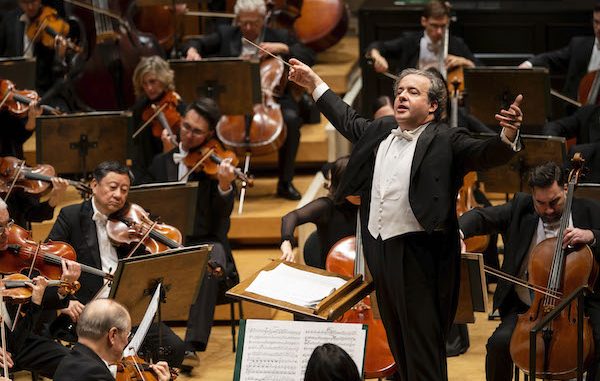
On Thursday, November 21, 2019, renowned Spanish conductor Juanjo Mena, Principal Conductor of the Cincinnati May Festival and Associate Conductor for the Spanish National Orchestra, returned to Symphony Center, 220 S. Michigan, Chicago, to lead the Chicago Symphony Orchestra (CSO) in a subscription concert to be repeated on Friday, November 22nd at Edman Memorial Chapel as part of the CSO’ s annual concert series at Wheaton College.
The concert will be performed again on Saturday, November 23rd at 8 P.M. and Sunday, November 24th at 3 P.M. at Symphony Center. The program, which featured the debut of lauded British soprano Sally Matthews and Women of the Chicago Symphony Chorus under the direction of Duain Wolfe, chorus director, includes two works before the intermission receiving their first CSO performances.

– James Lee III Sukkot Through Orion’s Nebula, 2011
This orchestral work, a commission from the Sphinx Commissioning Consortium, was premiered in Miami Beach, FL. in October 2011 by Conductor Michael Tilson Thomas and the New World Symphony Orchestra. The beautiful, shimmering and exultant work has been described by its composer, a practicing Seventh-day Adventist, as a message of religious redemption. Lee was inspired by the ideas of thanksgiving and harvest- Sukkot is the Hebrew Feast of the Tabernacles- coupled with the concept of Orion’s nebula, mentioned throughout the Old Testament. Finally, Lee notes that “a final festive celebration” and “the new Jerusalem” is mentioned in the Book of Revelation.
The jubilant, highly tonal work, including the sound of the shofar manifested in the French horn and trumpets, is propelled by percussive bursts. A sense of excitement is achieved through evocative high-register strings, free dissonances and chord clusters. Mena led the driving rhythms and colorful sweeps of detailed melody with brisk, emphatic gestures, the CSO responsively injecting a sense of urgency into the shifting metrics. Lee took his bows after the eleven-minute performance distinctly imbued with the energy and feel of sacred music/ music of the spheres.

– Samuel Barber Two Scenes from Antony and Cleopatra, Give me some music, Give me my robe, 1966/1968
Barber, whom musicologists have noted is, after Copland and Bernstein, “the most popular American composer of midcentury”, always felt that Antony and Cleopatra was his finest work. Certainly, it is a stirring and ingenious American opera with compelling richness and deep dramatic tonality.
Matthews brought to Cleopatra’s first aria, “Give me some music,” and the final aria, “Give me my robe”, a strong sense of the exotic Queen’s “quicksilver” moods. The arias soared from languorous to immediately ecstatic through immensely imperious with complex regret. It almost seemed as though Barber had tailored his music to this soprano’s specific voice, wide-ranging and yet distinctly controlled. With enormous poise and a projected hauteur, Matthews and the CSO, restrained and eloquent, gave us a queen conquering life and death.
– Gustav Holst The Planets, Suite for Large Orchestra, Op. 32, 1914-16
Holst had a lifelong interest in mysticism. His “series of mood pictures” represent an effort to portray the astrological meanings of the seven planets known at the time of composition (Pluto had not yet been discovered), in order of distance from the earth. The CSO, under the impassioned, enthusiastic baton of Mena, took the audience in Orchestra Hall on a vibrant interpretive journey through the celestial bodies.
Mars, the Bringer of War, demonstrated a frightening and relentless march into human terror. The percussion instruments, in superb emphasis throughout the entire concert, shone in stark relief, especially at the beginning of this segment.
Venus, the Bringer of Peace, followed with a lyrical, peaceful interlude characterized by particularly lovely horn, flute, harp and violin solos.
Mercury, the Winged Messenger, the briefest segment, reminiscent of Scherezade, was filled with gay staccato sounds and dancing scherzos from the wonderful CSO woodwinds and strings.
Jupiter, the Bringer of Jollity, perhaps the best known portion of this work, has an important majestic/quasi-religious central segment; the whole connotes a feeling of largesse and well-being.
Saturn, the Bringer of Old Age, contains a humorous and transporting “tick-tock” of percussion all through, and emphasizes the fleeting nature of this human life.
Uranus, the Magician, runs a delicious gamut from tongue-in-cheek threat through daring and witty; Mena seemed especially delighted in this piece, perhaps anticipating the finale.
Neptune, the Mystic, an otherworldly, ethereal piece, with sliding and mercurial tempos, gave the audience a burst of delight amid a frisson of wonder as the eerie, offstage, wordless exhaled chantings of the women’s choir hypnotized the audience from an unseen place.

For tickets and information about all the wonderful programming of The Chicago Symphony Orchestra, go to www.cso.org
All photos by Todd Rosenberg




Be the first to comment